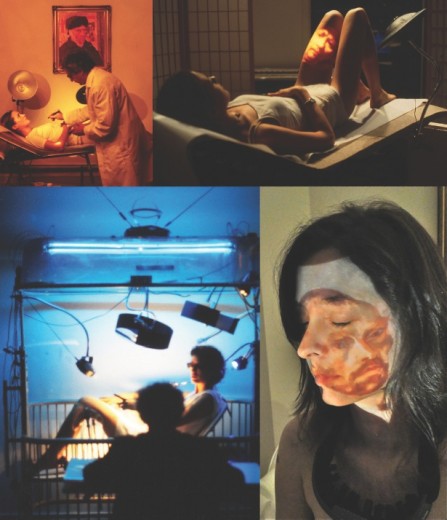 by Sarah Schmerler
by Sarah Schmerler
Chances are you have never met an iconoclast like Alexander Melamid. A conceptual artist turned self-proclaimed “art healer,” he’s had a pretty impressive (if the word can even apply to iconoclasts) career. Back in the 1990s, he was known as part of the duo Komar and Melamid, when their art was spotlighted in such august, fame-dispensing institutions as the Venice Biennale, Documenta, 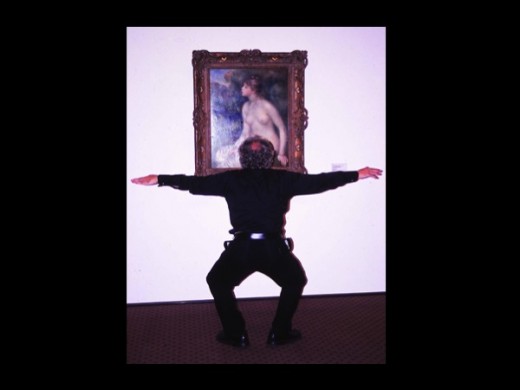 and the Guggenheim. Among other things, the two polled the American public and came up with “The Most-Wanted Painting in America”—a cheesy, bucolic landscape complete with George Washington, a deer, and other treacly fare. (It’s a project they did in 16 other countries as well, with equally queasy-making results.) Melamid split from Komar in 2004. At 66 years old, his work leans so far to the edge of irony that it makes Duchamp look conservative. These days, Melamid is concerned with reaching a greater public beyond the walls of museums, using masterpieces—or perhaps, the public’s sheeplike “faith” in fine art—as a method of healing ills of all sorts: insomnia, impotence, depression. Tongue planted firmly in cheek, he has declared himself an art healer, an art prophet, and even, yes, a deity. He’s given out art-healing communion (absinthe) on the streets of London; opened a functioning art-healing clinic in Soho (where you could strip and have masterworks like Van Goghs and Renoirs projected onto your body); and is currently serving as a bonafide healer, making rounds at Queens Hospital. Yes, he showed me his security badge, it’s real.
and the Guggenheim. Among other things, the two polled the American public and came up with “The Most-Wanted Painting in America”—a cheesy, bucolic landscape complete with George Washington, a deer, and other treacly fare. (It’s a project they did in 16 other countries as well, with equally queasy-making results.) Melamid split from Komar in 2004. At 66 years old, his work leans so far to the edge of irony that it makes Duchamp look conservative. These days, Melamid is concerned with reaching a greater public beyond the walls of museums, using masterpieces—or perhaps, the public’s sheeplike “faith” in fine art—as a method of healing ills of all sorts: insomnia, impotence, depression. Tongue planted firmly in cheek, he has declared himself an art healer, an art prophet, and even, yes, a deity. He’s given out art-healing communion (absinthe) on the streets of London; opened a functioning art-healing clinic in Soho (where you could strip and have masterworks like Van Goghs and Renoirs projected onto your body); and is currently serving as a bonafide healer, making rounds at Queens Hospital. Yes, he showed me his security badge, it’s real.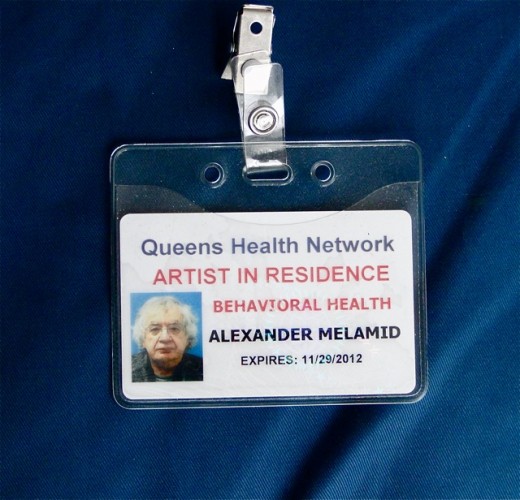 I met Melamid at a donut shop and found him to be a charming character of the A-1 variety; an artist who wants what every artist you’ve ever met wants: to save the world. Warning: before you read our conversation, know that Melamid is serious. He embodies what he is/does/says. Play along, or play…alone. P.S. He healed me.
I met Melamid at a donut shop and found him to be a charming character of the A-1 variety; an artist who wants what every artist you’ve ever met wants: to save the world. Warning: before you read our conversation, know that Melamid is serious. He embodies what he is/does/says. Play along, or play…alone. P.S. He healed me.
SS—Mr. Melamid… AM—That’s not my name. I just want you to know, you can’t call me that.
[taken aback] Okay…what shall I call you? That’s the name I took. It was simpler, you understand, to have a history, a past. You have heard of Melamid? I am more or less the same age as the original. Comrade Melamid: one of the greatest Russian artists who ever lived.
[confused] Really? He wasn’t really that famous, was he? [looks slightly hurt] Well, I suppose…perhaps not so much… but by Russian standards he has had a glorious past. And honestly, I am trying to make a career but it’s very hard here. As Melamid I have at least a past, some shows…you understand.
That’s fine, it’s only natural for artists: self merchandizing, branding. Yes, it’s only natural to want to brand. And I cannot pretend I am Jasper Johns. I mean, with this Russian accent? 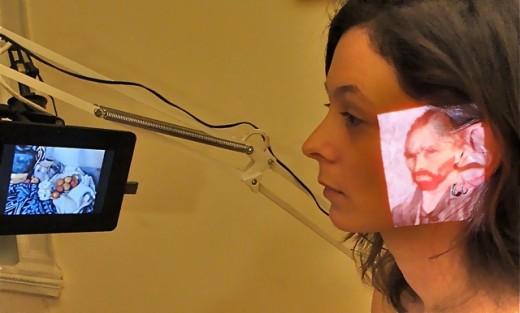
Yes, I see. Okay. Will you let me guess your real name? Is it something like “Malefischinski”? Something like that? Yes. That’s great. You can call me that.
Good. Mr.…Mr. Malefischinski, can we get started? Certainly.
Great, because I’m in need of healing. My problem isn’t that I don’t see enough art—my problem is that I see too much of it. And the big thing is, almost all of it is mediocre! I’m becoming genuinely anxious… No, no, no. Calm down. You have it all wrong! If we go deep down we understand there is no “good” or “bad” in art. In the 19th century there began a new notion, “art for art’s sake”; now, it has grown into a secular religion. Before [in other ancient, tribal cultures] art was depicted as having an outside power; now the power is within us. It is a [closed] system and museums and the like are its temples, its churches. When you are outside of a system, everything seems crazy, its beliefs nonsensical, but when you are inside it’s [fine]. Christianity, Marxism, Freud. There are still some Marxists out there! There are still people who believe that Freud made great discoveries! But it’s all lunacy. My parents said to me [as a child]: everything about art is good; you have to study it, you have to look at it. And only lately I’ve said: “Well, what is it exactly good for?” It’s good for this. For healing!
[Melamid takes out his laptop and a portable projector. I close my eyes. He beams an image on my forehead for about a minute. I feel much better.] Look, that’s what I used on you.
[An image of Vermeer’s portrait, “Woman with Pearl Earring” is projected on the donut shop wall.] I also must confess that I have a lot of trouble with money, making enough, managing it, keeping enough around, even for basic necessities. Wow. That’s serious. A nice person like you. What do you do? And why do you look at so much “mediocre art”?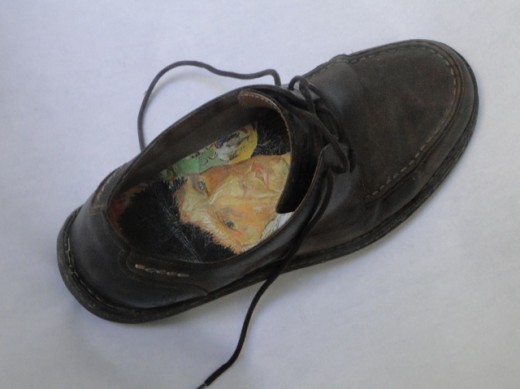
I’m an art critic. Ha! No wonder you don’t have any money! Being an art critic is one of the most unhealthy professions there is. It’s like working in medical science and saying you’re a medicine tester. Here you are, eating the medicine. What happens if you take too many aspirin? You get sick! You can’t experiment on humans. [Laughs] Maybe we should have animal testing for art critics?
Yes! I could take a hamster and put him in front of me, between me and the painting… A hamster would be fine. He would block the negative energies.
And if the hamster survives… …You would know, the art is not “bad,” it’s safe.
And if he dies… …if the hamster dies, the art is “bad.”
Would it be okay to take canaries to Chelsea? Canaries would work, sure. But wait, I have something for your finances.
[Melamid beams another image on my head. This time, an image of one of Andy Warhol’s Campbell’s Soup cans. Once again, I feel better, plus a bit warm and woozy.] Now you are cured. Your money problem will resolve itself in a couple of days. Don’t worry any more.
Thanks. So, are you G-d? Well, sure, yes, I am so great that…
Typical artist response. What’s your next project? I am instituting a prize for artists 80 years old and over. Like the Turner Prize, but for older artists. I feel we are in a time of senility. The end of a glorious epoch. Modernism started with young vigorous men with their penises up; now we are in a stage of the limp, of senility, and those greatest artists are of course older: Richter, the late Picasso, de Kooning. We forget things. “Neo-Senilism,” that’s the future of art. What’s happened years ago keeps happening over and over. I am now trying to get money for this prize.
Speaking of money, I am thinking of switching from art criticism to selling art. Do I have your blessing? Of course! That’s the only thing art is good for. To make money. Tell me, as a writer, are you paid for this article by the word, or are you given a flat fee?
A flat fee. Then we’d better stop, no? You’ve done too much already.
I agree.
Leave a Reply